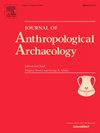Valencina: A copper age polity
IF 2.2
1区 社会学
Q1 ANTHROPOLOGY
引用次数: 0
Abstract
For a century, Copper Age Iberia (c. 3200-2200 BCE) has been seen as a grand laboratory for discussions of early social complexity. And yet, most theories were, from an empirical view point, infra-determined, as evidence was limited and restricted to a few sites. This situation has changed, as the availability of high-quality scientific data for a broader spectrum of sites now provides opportunities for fresh theoretical approaches. We propose a new take on emergent Iberian Copper Age social organisation, based on elements of political economy and collective action. We use the Valencina Copper Age mega-site, located in south-western Spain, to postulate the crucial role played by monumentalised central places in early complex societies. This site, and others like it, operated as attractors of large contingents of people, probably in the thousands, for social congregations that extended the fabric of society along a distinctive Neolithic pattern. Monument-building, largely (but not only) in the form of megaliths and ditched enclosures, brought people together, creating and maintaining a sense of belonging and cooperation, while at the same time keeping in check top-down impulses for more authoritarian and centralised political organisation. In the Neolithic tradition, monuments appear to create identity tied to place among expanding corporate social groups. Copper Age social formations lived in a ‘monument-oriented’ mode of production of sorts, in which the establishment of place and associated monumentalism served both to encourage and ‘burn’ surplus that could otherwise be manipulated and controlled by aspiring leaders. As part of this process, distinctive female leadership emerged at Valencina as materialized by identities supported by sumptuary objects made on exotic raw materials and produced by specialists. The social world built around Valencina as a monumentalised central place came to a rather abrupt end c. 2300, after which a different social medium, the Bronze Age, was started.
瓦伦西娜:铜时代的政体
一个世纪以来,铜器时代的伊比利亚(公元前3200-2200年)一直被视为讨论早期社会复杂性的大实验室。然而,从经验的角度来看,大多数理论都是不确定的,因为证据是有限的,而且仅限于少数几个地点。这种情况已经改变,因为高质量的科学数据的可用性为更广泛的地点提供了新的理论方法的机会。基于政治经济和集体行动的要素,我们提出了一种新的伊比利亚铜器时代社会组织。我们利用位于西班牙西南部的瓦伦西纳铜器时代的大型遗址,来假设在早期复杂社会中,纪念性的中心地区所起的关键作用。这个地方和其他类似的地方,吸引了大量的人,可能有成千上万的人,社会集会沿着独特的新石器时代模式扩展了社会结构。纪念碑的建造,在很大程度上(但不仅仅是)以巨石和围墙的形式,将人们聚集在一起,创造并保持了一种归属感和合作感,同时也抑制了自上而下的倾向于更专制和集中的政治组织的冲动。在新石器时代的传统中,纪念碑似乎在不断扩大的企业社会群体中创造了与位置相关的身份。铜器时代的社会形态生活在一种“以纪念碑为导向”的生产模式中,在这种模式中,地方的建立和相关的纪念碑主义都是为了鼓励和“燃烧”剩余,否则这些剩余可能被有抱负的领导人操纵和控制。作为这一过程的一部分,瓦伦西纳出现了独特的女性领导力,这些领导力通过由异国原料制成的奢侈物品和专家制作的物品来实现。以瓦伦西亚为中心的社会世界在2300年突然结束,之后开始了一种不同的社会媒介——青铜时代。
本文章由计算机程序翻译,如有差异,请以英文原文为准。
求助全文
约1分钟内获得全文
求助全文
来源期刊

Journal of Anthropological Archaeology
Multiple-
CiteScore
4.00
自引率
11.10%
发文量
64
期刊介绍:
An innovative, international publication, the Journal of Anthropological Archaeology is devoted to the development of theory and, in a broad sense, methodology for the systematic and rigorous understanding of the organization, operation, and evolution of human societies. The discipline served by the journal is characterized by its goals and approach, not by geographical or temporal bounds. The data utilized or treated range from the earliest archaeological evidence for the emergence of human culture to historically documented societies and the contemporary observations of the ethnographer, ethnoarchaeologist, sociologist, or geographer. These subjects appear in the journal as examples of cultural organization, operation, and evolution, not as specific historical phenomena.
 求助内容:
求助内容: 应助结果提醒方式:
应助结果提醒方式:


